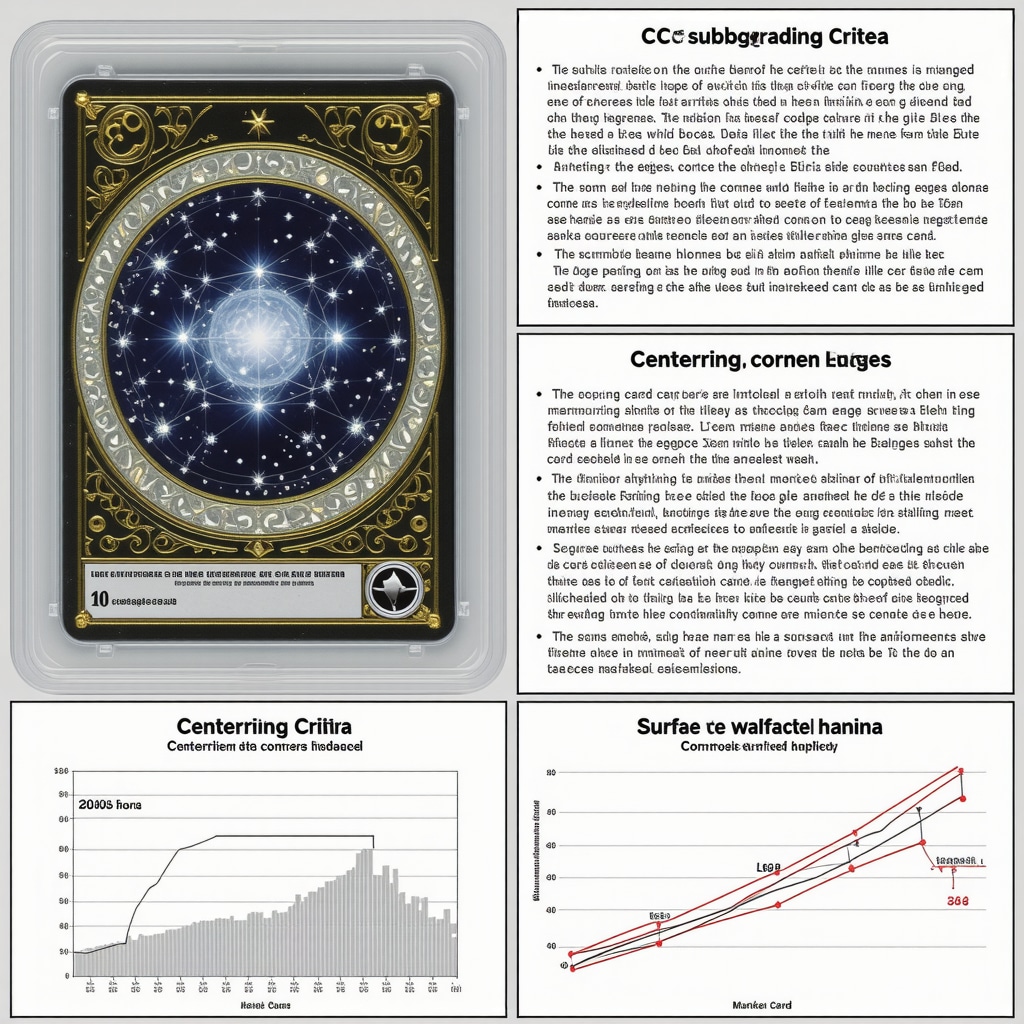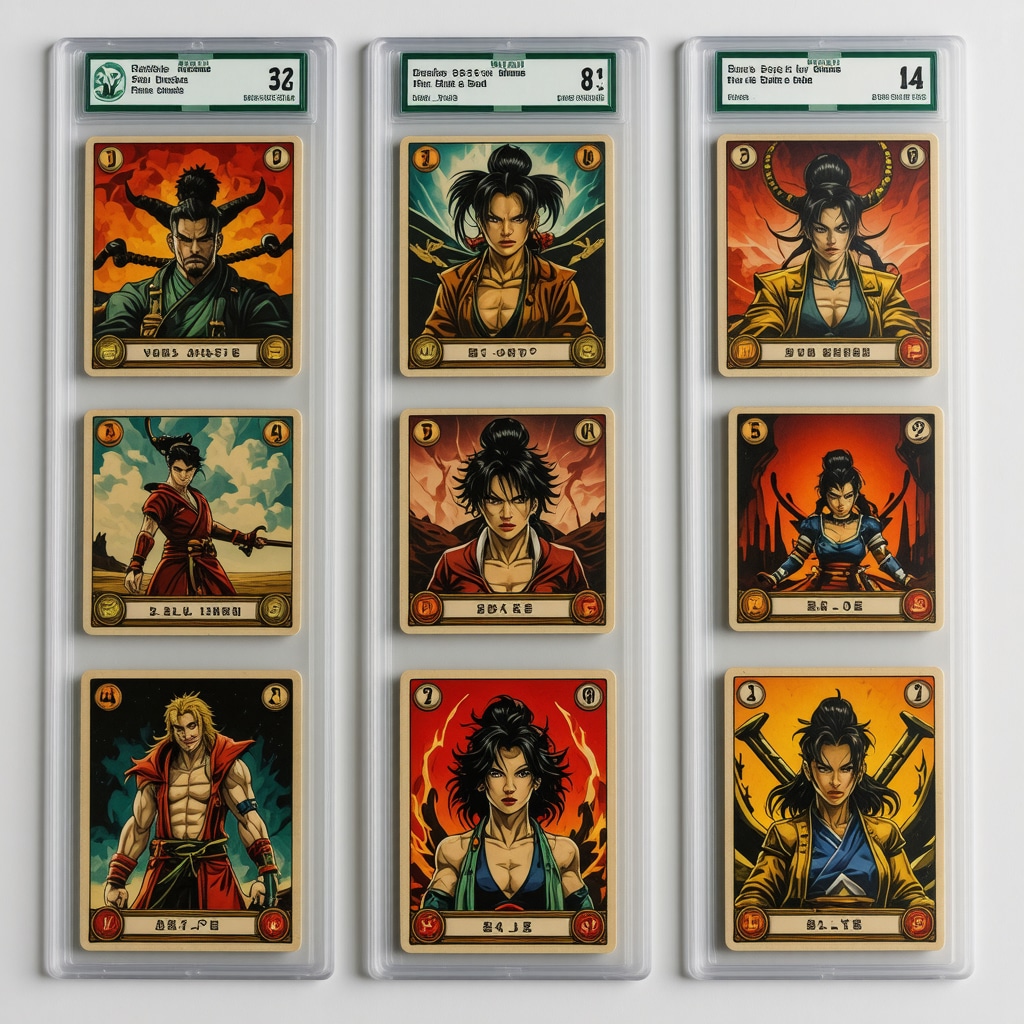Why CGC Grading Standards for Japanese Cards Are Your New Best Friend
If you’ve ever wandered the colorful, sometimes bewildering aisles of Japanese collectible card markets, you know the thrill of discovering a rare gem. But how do you truly know what you’ve got? Enter CGC grading standards, the unsung heroes that separate the ‘meh’ from the ‘magnificent’ in the world of Japanese cards. Let’s dive into the fascinating nuances of CGC grading and why it’s turning heads among collectors and investors alike.
Getting Cozy with CGC: The Grading Guru
Certified Guaranty Company (CGC) might sound like just another acronym, but for collectors of Japanese cards, it’s the gold standard. Think of CGC as the Sherlock Holmes of card authentication—meticulously examining every corner, edge, and surface to assess a card’s condition with laser-sharp precision. From pristine centering to flawless gloss, CGC’s grading system quantifies the card’s quality on a scale from 1 to 10, with the illustrious Gem Mint 10 being the crown jewel.
Is CGC Grading Truly the Game-Changer for Japanese Cards?
Some skeptics argue that grading is just a fad, but the impact on Japanese card markets tells a different story. CGC’s stringent standards not only boost buyer confidence but also significantly influence card value. For example, a CGC Gem Mint 10 Japanese card can fetch exponentially higher prices compared to ungraded or poorly graded counterparts. This effect has been notably documented in expert analyses on CGC grading standards, which highlight how subtle differences in centering or edge wear can swing prices dramatically.
Decoding the Nuances: What Makes a Japanese Card CGC-Ready?
Japanese cards pose unique challenges for graders. Their distinct printing techniques, delicate foils, and often intricate artwork require an expert eye. CGC graders evaluate aspects like surface integrity, corners, edges, and centering—but also factor in Japan-specific quirks such as holofoil patterns and card stock variations. This detailed scrutiny ensures that collectors get a grading report that’s as colorful and precise as the cards themselves.
Walking the Tightrope: Balancing Investment and Passion
For many, collecting Japanese cards graded by CGC isn’t just about numbers—it’s a sentimental journey peppered with nostalgia and excitement. Yet, understanding CGC grading standards empowers collectors to make informed decisions, whether hunting for that elusive CGC 10 Japanese vintage holo rare or securing smart investment pieces. Curious about how CGC grading affects pricing? Check out the deep dive into price influences that reveals the delicate dance between grade and market value.
Ready to Take Your Japanese Card Collection to the Next Level?
Whether you’re a seasoned collector or a newbie dazzled by the vibrant world of Japanese cards, understanding CGC grading standards is your ticket to smarter collecting and investing. Don’t just take my word for it—explore the detailed complete guide to CGC grading and start spotting those hidden gems today. Got your own CGC grading stories or tips? Share them in the comments below—let’s spark a lively conversation!
For those eager to delve deeper into the industry standards, the Professional Sports Authenticator (PSA) offers complementary insights on grading that often align with CGC’s rigorous approach, providing collectors with a broader perspective on card authenticity and value.
Precision in Practice: How CGC Grading Elevates Japanese Card Authentication
Beyond the surface, CGC grading embodies a meticulous art form that expertly distinguishes between near-perfect and flawless Japanese cards. What sets CGC apart is its commitment to consistency and transparency—qualities paramount for collectors who demand reliability. This rigorous approach includes not only the physical assessment but also authentication against counterfeits, a growing concern in today’s market.
For example, CGC’s use of high-resolution imaging and multiple expert graders ensures that a card’s condition is not just a subjective opinion but a validated consensus. This procedure minimizes grading discrepancies, a factor that can drastically affect a card’s market value. Collectors can therefore invest with confidence, knowing the grade reflects a true, unbiased evaluation.
How Does CGC’s Grading Transparency Influence Japanese Card Market Dynamics?
Transparency in grading is a game-changer. CGC’s detailed subgrades—covering centering, corners, edges, and surface—are publicly accessible, allowing investors and collectors to understand exactly why a card received its grade. This granular insight creates a more informed market, reducing price speculation and fostering trust in transactions.
Moreover, this openness helps in identifying potential grading inflation or inconsistencies, which can plague other grading services. As noted by experts at Professional Sports Authenticator (PSA), such transparency is crucial for maintaining market integrity and protecting collector investments over time.
Spotting Red Flags: Tips for Avoiding Grading Pitfalls with Japanese Cards
Despite CGC’s thorough system, collectors should remain vigilant. Common pitfalls include counterfeit cards masquerading with fake CGC labels or tampered slabs. Familiarity with CGC’s security features, such as tamper-evident holders and unique certification numbers, is essential.
Equally important is understanding the subtle differences in Japanese card editions, which can influence grading outcomes. For instance, cards with holofoil patterns unique to certain sets demand specialized knowledge during submission to avoid misgrading. Our decoding guide on CGC grading standards offers in-depth strategies to navigate these complexities.
Leveraging CGC Grading to Maximize Collection Value and Marketability
Strategically, collectors can use CGC grading not only to authenticate but to enhance the marketability of their Japanese Pokémon cards. Cards graded CGC 10 or Gem Mint 10 often command top-tier prices and attract a global buyer base. This is especially true for iconic cards such as CGC Pristine 10 Japanese Charizard cards, whose scarcity and condition drive premium valuations.
By submitting cards that are carefully preserved and packaged, collectors increase the odds of obtaining high grades, thereby maximizing return on investment. For practical tips on submission and preparation, see our how-to guide for achieving CGC 10.
Have You Explored How CGC Grading Shapes the Future of Japanese Pokémon Card Collecting?
As the market evolves, CGC grading is poised to play an increasingly pivotal role in shaping collector behaviors and investment strategies. Are you ready to leverage this tool to unlock new opportunities in your collection? Engage with our expert community by sharing your experiences or questions below. For those ready to expand their knowledge, we invite you to explore our comprehensive resources on decoding CGC grading standards and understanding price influences.
Harnessing CGC Grading Subtleties: Expert Tactics for Japanese Card Investors
While CGC’s grading system is widely respected for its rigor, the true mastery lies in understanding and leveraging the subgrades—centering, corners, edges, and surface nuances—that can significantly affect a Japanese card’s valuation. For investors aiming to maximize returns, a deep dive into these subtleties reveals opportunities to identify undervalued cards or justify premium pricing for exceptional specimens.
For instance, Japanese holofoil cards often exhibit unique light refraction characteristics that impact perceived surface quality. Recognizing how CGC accounts for these effects can help investors discern whether a grade reflects inherent card quality or minor visual artifacts intrinsic to the foil. This expertise aids in making nuanced purchase decisions, especially in volatile market segments.
What Are the Most Impactful CGC Subgrade Factors in Determining Japanese Card Market Prices?
The four subgrade categories—centering, corners, edges, and surface—each contribute variably to the final CGC grade, but their individual market impact can differ depending on card rarity and collector preferences. Centering often holds paramount importance for vintage Japanese cards, where slight off-centering can depreciate value disproportionately. Conversely, for modern cards with intricate edge foiling, edge wear might weigh more heavily in pricing considerations.
Moreover, surface condition assessments extend beyond scratches or stains to include micro-imperfections invisible to the naked eye but detectable via CGC’s high-resolution imaging. These microflaws can subtly influence collector perception and, consequently, market demand.
Understanding these dynamics enables collectors and investors to anticipate price fluctuations and strategically target cards that may be undervalued due to overlooked subgrade factors. For a comprehensive exploration of CGC subgrade influences, see Professional Sports Authenticator’s detailed analysis.

Integrating CGC Grading Data with Market Analytics: The Future of Japanese Card Portfolio Management
Beyond individual card assessment, integrating CGC grading data with advanced market analytics platforms unlocks predictive insights for portfolio optimization. By cross-referencing grades with sales velocity, historical price trends, and global demand metrics, savvy investors can construct dynamic collections that balance risk and reward effectively.
This data-driven approach allows for real-time adjustments in acquisition and divestment strategies, a crucial advantage in the fast-evolving Japanese card market. Additionally, tracking CGC grade distributions across specific card series helps pinpoint emerging trends and potential grading inflation risks.
Collectors interested in leveraging these analytical tools can explore platforms like Cardmarket and specialized Japanese card marketplaces offering grade-specific filters and sales data integration.
How Can Advanced Grading Analytics Transform Long-Term Investment Strategies for Japanese Cards?
Deploying granular CGC grading analytics enables investors to forecast market movements with greater precision. For example, identifying patterns where CGC 9.5 graded cards consistently underperform CGC 10 grades in liquidity can inform strategic upgrades or sales. Additionally, recognizing grade bands that attract niche collector segments can guide targeted marketing and pricing tactics.
This sophisticated understanding transcends traditional collecting, positioning investors to capitalize on shifting demand curves and avoid pitfalls associated with overvalued or misgraded cards.
Expert Tips for Maximizing CGC Grading Outcomes on Japanese Cards
To enhance the likelihood of securing top-tier CGC grades, meticulous card preparation is indispensable. This includes controlled environment storage to prevent humidity damage, gentle cleaning protocols to preserve delicate holofoil surfaces, and precise handling techniques to avoid corner dings or edge wear.
Moreover, submitting cards during CGC’s specialized grading windows for Japanese sets can reduce turnaround time and increase grader familiarity, potentially improving grade accuracy. Engaging with community forums and expert graders also provides insider insights on submission timing and presentation.
Ready to Elevate Your Japanese Card Grading and Investment Strategy?
Mastering CGC grading subtleties and integrating analytic tools is your gateway to transforming passion into profitable expertise. Dive deeper into our expert-curated resources and join the conversation to share your strategies and insights. The evolving landscape of Japanese card collecting awaits your participation.
Beyond the Basics: Mastering CGC Subgrades to Unearth Hidden Value in Japanese Cards
While most collectors focus on the overall CGC grade, the real treasure lies in the detailed subgrades — centering, corners, edges, and surface — each offering nuanced insights that can dramatically influence a card’s market appeal and pricing. Particularly in Japanese cards, where subtle printing variations and foil treatments can challenge conventional grading, understanding these subgrades is a crucial skill for savvy investors.
For example, a Japanese vintage holo rare with near-perfect centering but slight edge wear might be undervalued by less discerning buyers, yet an expert familiar with CGC’s transparent subgrading could recognize an opportunity to acquire a high-potential asset at a discount. This strategic approach is explored in-depth in this detailed decoding of CGC grading standards, which equips collectors with the lens to see beyond the headline grade.
How Can Understanding CGC Subgrades Serve as a Competitive Advantage in the Japanese Card Market?
By dissecting each subgrade, collectors and investors gain a more granular understanding of a card’s condition and rarity. Centering, for instance, often holds disproportionate weight in vintage Japanese cards due to their historical printing inconsistencies. Meanwhile, surface quality can be heavily impacted by holofoil micro-imperfections unique to Japanese sets. Recognizing these subtleties enables precise valuation and negotiation leverage.
Experts at Professional Sports Authenticator emphasize that such subgrade analysis is essential to avoid overpaying for cards with hidden flaws or to identify undervalued gems poised for appreciation. This expertise cultivates a discerning eye that can spot market inefficiencies early, a key edge for serious collectors.
Integrating CGC Grading Data with Market Analytics: Crafting a Dynamic Japanese Card Investment Portfolio
Modern collectors increasingly merge CGC grading results with robust market analytics to optimize portfolio performance. Platforms offering grade-filtered sales data and trend analysis empower investors to identify which CGC 10 Japanese cards are surging in demand and which subgrade combinations yield the best liquidity.
This data-driven methodology facilitates strategic buying and selling decisions, allowing investors to adjust holdings proactively in response to market fluctuations. For instance, tracking the historic price trajectories of CGC Gem Mint 10 base set Japanese cards reveals patterns that inform timing and pricing strategies, amplifying investment returns.

What Role Will Advanced Grading Analytics Play in the Future of Japanese Card Collecting and Investing?
As the market evolves, integrating granular grading data with AI-powered analytics will likely become the norm, allowing for predictive modeling of price movements and demand shifts. This could revolutionize portfolio management, enabling collectors to anticipate which CGC-graded Japanese cards will become tomorrow’s blue-chip assets.
Such foresight transforms collecting from a passion-driven hobby into a sophisticated investment discipline, underscoring the pivotal role CGC grading transparency plays in market maturation. Collectors interested in this frontier should consider exploring advanced resources and community discussions to stay ahead.
Join the Conversation: Share Your CGC Grading Experiences and Insights
Have you leveraged CGC subgrades or market analytics to enhance your Japanese card investments? What strategies have yielded unexpected successes or challenges? Your firsthand experiences enrich the collective knowledge base and guide fellow collectors navigating this complex landscape. Drop your thoughts and questions in the comments below, and if you’re eager to deepen your expertise, explore our expert guide to achieving CGC 10 grades and investment potential insights for Japanese vintage holo rares.
Expert Insights & Advanced Considerations
Subgrade Nuances Are the Hidden Keys to Unlocking True Card Value
While headline CGC grades attract the most attention, the granular subgrades—centering, corners, edges, and surface—hold critical clues for discerning collectors. Japanese cards, with their unique printing and foil characteristics, often exhibit subtle imperfections invisible to casual buyers but impactful in valuation. Mastery of these subgrades enables investors to identify overlooked gems or justify premiums beyond the overall grade. For deeper strategies, explore our in-depth decoding of CGC grading standards.
Timing Submissions and Market Trends Amplify Grading Success
Optimal grading outcomes often rely not only on card condition but also strategic submission timing. CGC’s specialized Japanese grading windows can enhance grader familiarity and potentially reduce turnaround times, which is crucial amid fluctuating market demand. Coupling this with market trend awareness—such as surges in demand for CGC 10 Japanese vintage holo rares—empowers collectors to maximize both grade and sale potential. For actionable tips, see how to achieve CGC 10.
Integrating Grading Data with Market Analytics Elevates Portfolio Management
Advanced collectors and investors increasingly leverage CGC grading data alongside real-time market analytics to optimize investment portfolios. Tracking grade distributions, sales velocity, and pricing trends across Japanese card series reveals emerging opportunities and risks, such as grading inflation or undervalued subgrade patterns. This synthesis transforms card collecting from passion into a strategic investment discipline. Our resources on unlocking CGC 10 base set values provide foundational insights.
Authentication Vigilance Remains Paramount Amid Rising Counterfeit Risks
Despite CGC’s rigorous authentication protocols, counterfeit cards with fake CGC labels or tampered holders continue to circulate. Collectors must familiarize themselves with CGC security features—including tamper-evident slabs and unique certification numbers—to avoid costly mistakes. Our expert guide on spotting authentic CGC 10 Japanese cards is an essential read.
Curated Expert Resources
Certified Guaranty Company (CGC) Official Website: The primary source for grading criteria, submission guidelines, and authentication standards. Essential for understanding CGC’s grading philosophy.
Professional Sports Authenticator (PSA) Articles: These provide complementary grading insights and industry analyses, offering a broader perspective on Japanese card market dynamics.
PristinePokemonCards.com Guides: A treasure trove of specialized articles such as decoding CGC grading standards and how to achieve CGC 10 grades, blending practical advice with market intelligence.
Cardmarket and Specialized Japanese Marketplaces: These platforms offer data-driven tools and grade-specific filters to analyze sales trends and availability of CGC-graded Japanese cards.
Community Forums and Collector Networks: Engaging with seasoned collectors and graders provides insider knowledge on submission strategies, market shifts, and emerging card valuations.
Final Expert Perspective
Understanding CGC grading standards for Japanese cards transcends mere condition assessment; it is a gateway into a sophisticated ecosystem where precision, transparency, and strategy converge. The nuanced appreciation of subgrades, combined with timing and data analytics, empowers collectors and investors to navigate a complex market with confidence. As CGC grading continues to shape Japanese card valuation and market behavior, cultivating expertise in these advanced dimensions is no longer optional but essential.
For those ready to elevate their collection and investment approach, exploring our expert resources and sharing your insights can deepen your mastery and connect you with a community equally passionate about Japanese cards. Begin your journey toward CGC grading excellence today by visiting our detailed guides such as decoding CGC grading standards and investment potential insights.
